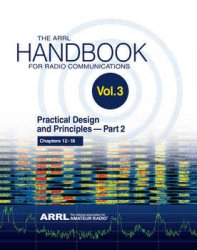The ARRL Handbook for Radio Communications; Volume 3: Practical Design & Principles PART 2
- Добавил: literator
- Дата: 28-03-2019, 04:15
- Комментариев: 0
 Название: The ARRL Handbook for Radio Communications; Volume 3: Practical Design & Principles PART 2
Название: The ARRL Handbook for Radio Communications; Volume 3: Practical Design & Principles PART 2 Автор: ARRL Inc.
Издательство: ARRL, the National Association for Amateur Radio; 96 edition
ASIN: B07HNPSDVV
Год: 2018 (2019 edition)
Страниц: 734
Язык: английский
Формат: epub
Размер: 22.8 MB
Receivers have traditionally been at the forefront of Amateur Radio technology and certainly are today, even as the long-reigning analog superheterodyne architecture is being overtaken by the digital software defined radio. While commercial designs and devices abound, receiving in the crowded amateur bands is still a demanding application with strong signals immediately adjacent to signals at the noise floor, a variety of natural and man-made interferences to reject, and modes ranging from manually sent Morse to the latest experimental modulations.
The major subsystems of a radio receiving system are the antenna, the receiver and the information processor. The antenna’s task is to provide a transition from an electromagnetic wave in space to an electrical signal that can be conducted on wires. The receiver has the job of retrieving the information content from a particular signal coming from the antenna and presenting it in a useful format to the processor for use.
The processor typically is an operator, but can also be an automated system. When you consider that most “processors” require signals in the range of volts (to drive an operator’s speaker or headphones, or even the input of an A/D converter), and the particular signal of interest arrives from the antenna at a level of mere microvolts, the basic function of the receiver is to amplify the desired signal by a factor of a million. It must do this, while in the presence of signals many orders of magnitude greater and of completely different characteristics, without distortion of the desired signal or loss of the information it carries.
Contents:
12 Receiving
13 Transmitting
14 Transceiver Design Topics
15 Digital Protocols and Modes
16 Amateur Radio Data Platforms
17 RF Power Amplifiers
18 Repeaters
Скачать The ARRL Handbook for Radio Communications; Volume 3: Practical Design & Principles PART 2
Внимание
Уважаемый посетитель, Вы зашли на сайт как незарегистрированный пользователь.
Мы рекомендуем Вам зарегистрироваться либо войти на сайт под своим именем.
Уважаемый посетитель, Вы зашли на сайт как незарегистрированный пользователь.
Мы рекомендуем Вам зарегистрироваться либо войти на сайт под своим именем.
Информация
Посетители, находящиеся в группе Гости, не могут оставлять комментарии к данной публикации.
Посетители, находящиеся в группе Гости, не могут оставлять комментарии к данной публикации.
